
TweetDeck - Quick Guide
TweetDeck - Twitter & Microblogging
Need for Microblogging
The Internet has revolutionized the way we share information. Blogs have provided an indispensable platform to express both personal opinions and entrepreneurial ideas unhindered by the limitations of conventional media. There are blogs on almost every subject on the Internet and most blogs allow interactive communication between the author and the readers. However, time is a very limited resource and there needs to be a way to get information across concisely without bogging the reader with too many details. There is also a need for enhanced connectivity and interactivity more than what a conventional blog post can afford. Microblogging has evolved to meet these concerns.
Twitter and Other Microblogs
Microblogs, initially called, Tumblelogs, allow sharing of short snippets of information in a quick and easy manner. The information can be a short sentence or a link to a web page or other multimedia content. The most popular microblogs include Facebook, Twitter and Tumblr. Of these, Twitter has revolutionized the microblogging sphere by limiting the total number of characters that can be shared to just 140, a little short of the length of an SMS.
Twitter was founded by Jack Dorsey, Noah Glass, Biz Stone and Evan Williams in 2006. Since then, Twitter has grown exponentially to become the SMS of the Internet. This has spawned a new generation of Internet users who have managed to convey their thoughts within the limits of Twitters character limit by devising clever language tactics and URL shortening.
Thus, Twitter has become the de facto medium to get real time happening information from all over the world and is the most popular microblogging platform. So much so, that even celebrities and Heads of States use the platform to connect instantly with their followers.
Accessing Twitter
With millions of tweets exchanged by the hour, Twitter has become the best source of instant breaking news of virtually any topic under the sun. The Twitter service can be accessed by registered users via the Web, Mobile Apps and even by SMS. Although Twitter is a complete enough service by itself, its popularity begets more flexibility as power users would like more functionality that helps in enhancing their productivity. There has been a spurt of third party clients over the recent years providing enhancements over the native Twitter experience for almost all OS platforms, but the popular one remains Twitters own client, TweetDeck.
In this tutorial, we will explore how to get the most out of Twitter using TweetDeck and learn some of the customization options it offers along with a brief look at other popular third party clients as well. Having firsthand knowledge of TweetDeck will greatly help in fully harnessing Twitters potential, so lets get started!
TweetDeck - The Twitter API
An Application Programming Interface (API) is a set of calls that enable software to communicate with each other. APIs help developers to understand the correct way of calling a procedure and interfacing with the software and/or the Operating System. The format or syntax for calling these functions is provided in the developer documentation for the software and released as part of a Software Development Kit (SDK). Before delving into the API, it is important to be familiar with the Twitter Developer Policies and the OAuth authentication protocol before using it them in an app.
Components of the Twitter API
The Twitter API has four main objects −
- Tweets
- Users
- Entities
- Places
The detailed documentation of each of these above-mentioned objects is available on the following link https://developer.x.com/en/docs/x-api This website is a huge repository of a lot of Twitter libraries containing code from Java to Objective-C, spanning almost all device form factors.
There are different APIs within Twitter which includes −
- REST
- Streaming
- Ads
- Gnip
- MoPub
- Fabric, etc.
The most important of them being REST API and Streaming API. The REST API provides read and write access to Twitter data and supports most of the functionality when used along with OAuth. The Streaming API allows for real time streaming of public data in the users feed.
Restrictions of the Twitter API
Each third-party client is provided with an API key that is unique to it. An important thing to note is that if the application is mimicking Twitters full functionality; the API allows only 100,000 tokens to be registered i.e. the third-party client can support only 100,000 registered users. This is done to ensure the quality of service by the API. This is also the reason why most of the thirdparty clients need to be purchased to use them.
It presents an interesting paradox as the core service and the official application themselves are free while most of the third-party clients need to be purchased. Due to the above-mentioned token limit, purchasing the applications ensures that only legitimate users access Twitter via the third-party application. The pricing is justified by adding a lot of additional and power user functionality which is often not found in the official web or mobile apps.
TweetDeck - Third-Party Twitter Clients
Given the immense popularity of Twitter as a means of instant communication, it is only natural that it enjoys a lot of developer patronage. Although the Twitter website is the primary means of accessing the service, which the majority uses, it leaves a lot to be desired for power users. Things like multi-account login, multi-panel view, tweet scheduling and feed customization are some of the features that are present in third party apps. We are of course, focusing specifically on TweetDeck but lets also have a look at some of the most popular third party Twitter clients and find out what makes them worth the dough.
Some of the most popular and trending third-party Twitter clients are as follows. Each of these have been described in detail for understanding their functionality.
The list includes −
- Hootsuite
- Fenix For Twitter
- Tweetbot
- Fenice For Twitter
Hootsuite
This was one of the original applications that helped in managing multiple social networks at once. A user can check Facebook, Twitter, LinkedIn, Instagram, etc. from a single interface. Professional users get to use the analytics tool as well. This is a free app available on the Android and iOS platforms along with optional in-app purchases. The link to download Hootsuite for the android platform from the google play application is https://hootsuite.com/.
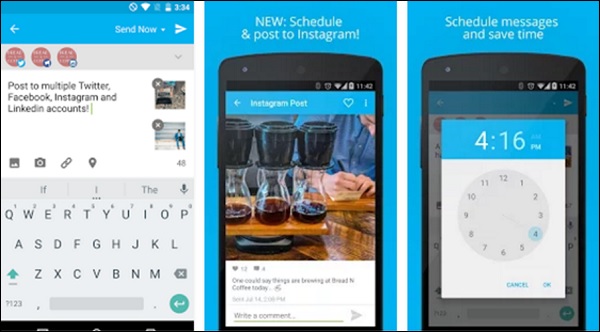
Fenix for Twitter
Fenix is a popular Twitter app that sticks to Googles Material Design guidelines and as such is aesthetic to look at. It comes with the standard Twitter functionality along with support for multiple accounts, real-time updates and yes, a dark theme! It is not free however and will set you back by $5.69, but is well worth the money.
The link to download Fenix for Twitter for the android platform from the google play application is https://fenix-for-twitter.en.softonic.com/android
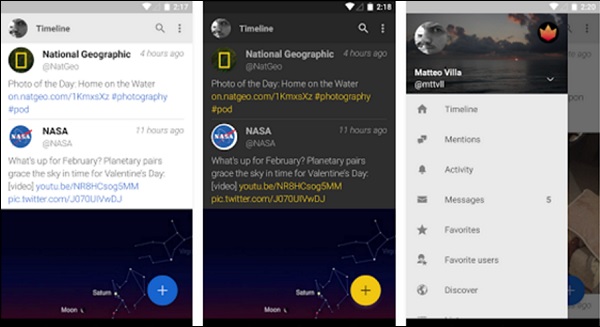
Tweetbot
Tweetbot calls itself, a Twitter client with personality and is rightly so. It is one of the most aesthetic Twitter clients available on any platform. This is an iOS exclusive app so Android and Windows Phone users are out of luck.
Tweetbot uses a gesture-based navigation system and provides a list of curated group of Twitter users allowing to view them in a sleek timeline. It also comes with a native support for Pocket, Instapaper, Readability, CloudApp etc. Tweetbot 4 adds support for the latest iOS 9 as well as for the iPad and Apple Watch.
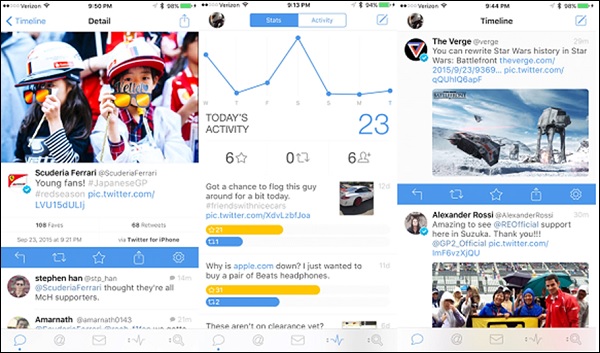
The link to download Tweetbot for the iOS platform from the iTunes store is https://apps.apple.com/us/app/tweet-bot-auto-comment/id6474156344
Fenice for Twitter
Windows Phone (or Windows 10 Mobile) may not have tasted much success compared to Android or iOS, but that hasnt stopped the enthusiastic developers from developing for this platform. With the promise of Universal Windows Apps (UWA) that run on everything from phones to tablets to even the Xbox and holographic displays, developers are slowly but surely embracing this platform.
Fenice for Twitter is a Windows 10 UWA that has garnered critical acclaim. It features interactive notifications, live tiles, streaming feeds, ability to send offline tweets, integration with Instapaper and Pocket along with Cortana integration for hands-free operation. At $1.99, one purchase is enough for use on up to ten Windows 10 devices.
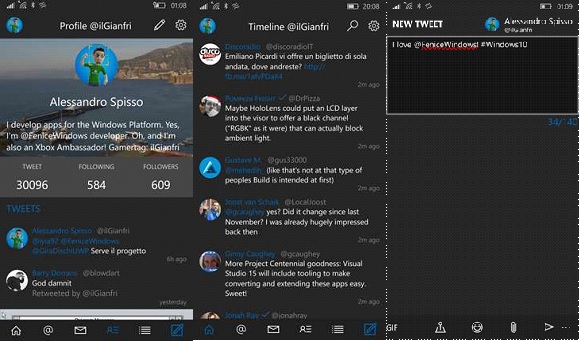
The link to download Tweetbot for the Windows platform from the Microsoft Store is https://apps.microsoft.com/detail/9nblggh2plfg?hl=en-GB&gl=IN
This was obvious. The official Twitter app is still a good app for those who do just basic twittering and do not have much use for some of the advanced features offered by third-party clients. This application offers a near native Web experience, so people who frequent the website will find themselves at home.

The latest updates also feature multi-account support and most importantly, two-factor authentication for additional security. The best advantage of using this app is that it is not affected by backend changes to the Twitter API, which can sometimes break third-party clients and that also means, no issues with the token limit.
The TweetDeck Client
TweetDeck is best described as a Social Media Dashboard for the Management of Twitter Accounts. It started off as a separate company led by Ian Dodsworth, but was acquired by Twitter in 2011 for 25 million. Like the other clients mentioned above, it uses the Twitter API to deliver news feeds and allows users to respond to tweets and follow others.
It is currently the most used client for Twitter after the actual Twitter website. Although the native TweetDeck Client Windows has ceased any further development, there are still clients available for the Mac OS X, Google Chrome and of course as a web app on the following link https://www.tweetdeck.twitter.com. The power users will appreciate the presence of keyboard shortcuts for common functions.
Earlier, TweetDeck had support for other social networks such as Facebook, LinkedIn, MySpace, etc. apart from Twitter, but since 2013, it dropped support for other networks and focused more on the core Twitter experience. The most striking feature of TweetDeck is its ability to display multiple timelines at once. It also includes a lot of the more advanced features such as −
- Multi-Account Support
- Scheduling Tweets
- Building Collections, etc.
It can also delegate access to teams wherein multiple people can share a Twitter account without having to share the password.
Exploring the TweetDeck User Interface
The TweetDeck interface is divided into columns of different aspects of the Twitter profile. The columns can be customized based on what one would like to see in the newsfeed. The typical TweetDeck interface has a four-column setup that displays Home, which contains the streaming news feed made possible by the Streaming API, the Notifications feed, the Activity feed and the Direct Messages or the Messages feed.
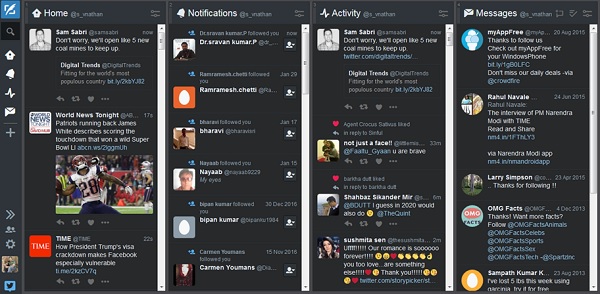
Each of these columns are dynamic and continuously updated in real time giving a sense of a dashboard. The icons to the extreme left of the interface contains options for composing a new tweet, searching for users and topics and an icon for each of the columns selected for display showing the number of unread or new items. One can add additional columns from here. It also contains options for managing user accounts and settings for keyboard shortcuts and search terms.
Customization Options of the Side Panel
The side panel allows composing a new tweet and searching Twitter for people, topics, etc. The panel shown in this example (the screenshot beside) is configured by default to show the following options −
- Home
- Notifications
- Activity
- Message feeds
The positioning of these feeds can be interchanged simply by dragging and dropping them in the desired order. By clicking on the Collapse Button simply collapses the panel into simple icons giving more screen space for other panes.
The Accounts Button allows adding multiple accounts or joining a team which we will be reviewing in the subsequent chapters.
The Settings Panel allows configuring a lot of settings some of which reflect across both Twitter and TweetDeck.

Finally, clicking the profile picture, brings up a pop-up showing the Twitter Profile of the current logged in account.
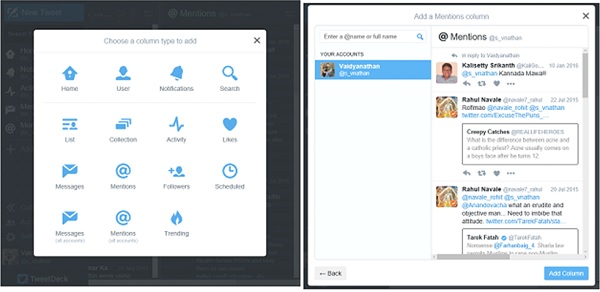
The Add Column button brings up a pop-up showing the various other columns that can be added. One can simply add columns by clicking on a column type from the available list. Clicking on a column type will further open options to be included. For example, I have chosen to add the Mentions column to my timeline.
Clicking on the Mentions column will open options for adding the mentions that I have been a part of. I can also choose to include Mentions of other Twitter accounts like that of a celebrity for example.
Finally, press Add Column at the bottom right to add the column to your main landing page. The options displayed are contextual and vary based on the type of the column chosen. A user can have as many columns as needed if it doesnt feel that the interface is getting cluttered.
The Settings Menu
The Settings menu presents the following options
- General
- Link Shortening
- Mute
Let us now discuss each of these in detail.
General Settings
In the General Section, you can choose to stop the real time streaming of tweets which is useful if there is a whole barrage of tweets and you need time to keep up with each of them. The Notifications can be turned on or off and it also includes a filter for displaying sensitive media. There are options to choose a Dark or a Light theme. A dark theme is particularly useful when using the app on AMOLED displays. It saves battery power and prevents screen burn-in and is also easy on the eyes.
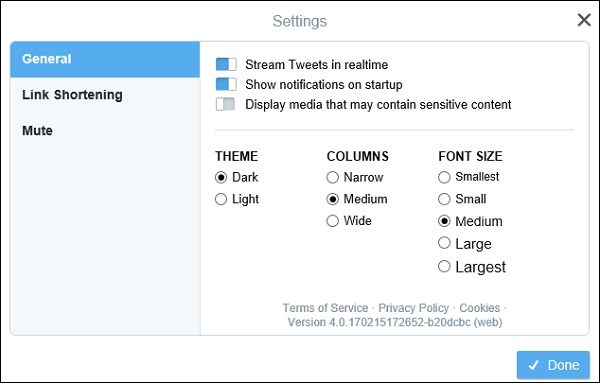
The width of the columns can be set as narrow, medium or wide. It is worth noting that there is no free size resizing option i.e. you cannot drag the columns to occupy a desired width on the main interface and you are left with one of these three choices.
Finally, there is the option to change the font size from smallest to largest again, no custom sizes possible.
Link Shortening
The Link Shortening section enables using Twitters t.co URL shortening or the Bit.ly URL shortening service. URL shortening is often required to condense long URLs and accommodate them along with the actual tweet as tweets are limited to just 140 characters.
Outside the app, you can of course, use other third-party URL shortening services as well.
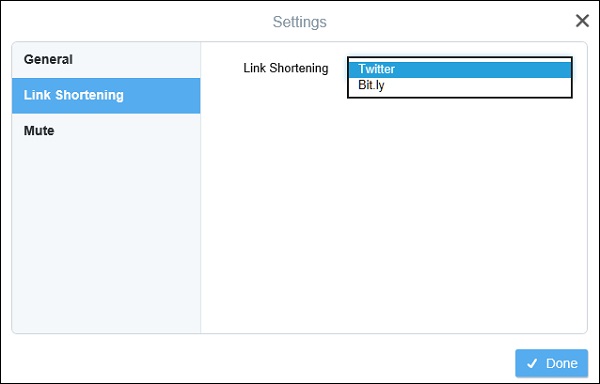
Mute Settings
The Mute section offers options to mute certain words or phrases which you dont want to see on your timeline. For example, if too many political news are dominating your feed, you can mute specific news sources or words, so that they dont show up and distract your view.
Of course, this is completely reversible. It is interesting to note that these preferences also apply simultaneously to your main Twitter profile.
Press Done to return to the main newsfeed.
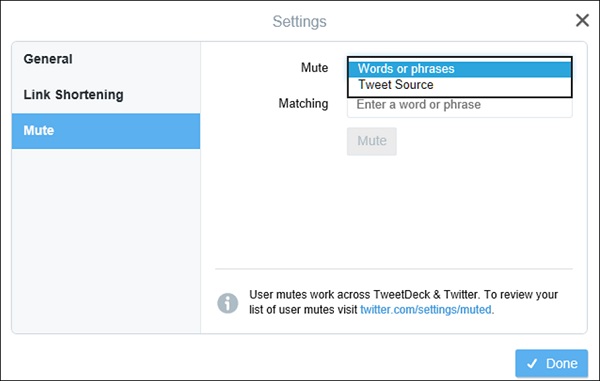
TweetDeck Panel Customization Options
Apart from the global settings, each panel added to the main interface has individual options for customization as well. Let us have a look at an example of the Home panel and explore the options it presents.
Clicking on the Filter icon on the top right of the panel opens a flyout detailing various options related to that panel. Here we see for the Home panel that the options are categorized into
- Content
- Users
- Alerts
- Previews
Let us now discuss each of these in detail.
Content − Opening the content drop down allows you to customize your feed to show all tweets or just tweets with GIFs, images, videos, vines, links, etc. You can also enter specific keywords to include or exclude and choose whether to show retweets or not.
Users Menu − The Users menu allows you to display tweets by specific users or filter only verified ones (such as those of celebrities or popular brands).
Alerts Menu − The Alerts menu allows you to specify sounds and desktop notifications for every update that occurs (Note Your browser may ask for permission to enable notifications).
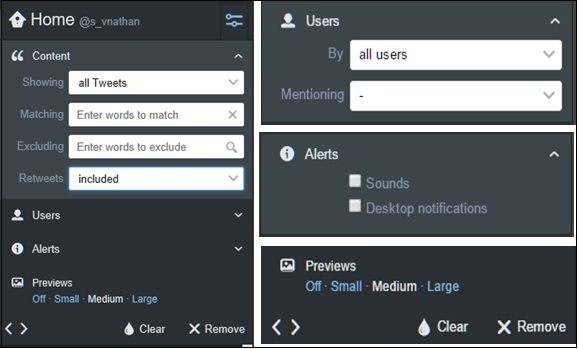
Preview Options − The Previews options allows for adjusting the size of the previews of photos or videos displayed. These drop downs are mostly common for all the panes.
Clear Button − The clear button clears the current visible data in the pane.
Remove Button − Clicking on Remove will remove the pane completely. Of course, the pane can be re-added via the Add Column button as described earlier.
Some panes such as Notifications, Messages, etc. contain additional options apart from these. The bottom row of the interface has two arrows. These arrows help in shifting the position of the pane left or right.
Simply exploring the interface can unearth a lot of options and allows the user to customize TweetDeck exactly as per his/her needs. The options presented are much more than what Twitter natively offers on either its official website or app and we can see why TweetDeck and other clients are quite popular among Twitter aficionados.
Using Multiple Twitter Accounts
TweetDeck allows multiple account management by two methods The first one is to add Twitter accounts directly within the app. The other is by delegating access to another Twitter account to post on your behalf without requiring a password.
Clicking on the Accounts button on the side pane allows addition of another Twitter account.

Note − TweetDeck allows login or addition with existing accounts only; creating new accounts must be done via the Twitter website. Adding a new account allows adding columns for various functions for that account.
Taking the Mentions column that we added earlier as an example, we can now have a Mentions panel for the new account by going to Add Column. However, the streams from both the accounts cannot be merged into a single pane.
Adding multiple accounts presents some interesting possibilities. You can select the default account to use for your Twitter needs by going to Accounts section on the side pane, expanding the desired account, and selecting the Default Account option as shown in the following screenshot.
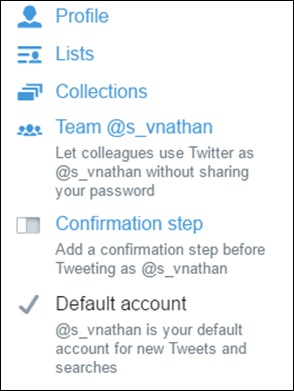
Note − You cannot remove an account marked as default from the current TweetDeck session. You can tweet from multiple accounts at once. Simply go to the New Tweet section and select the accounts you wish to tweet from.
It is also possible to follow a person or like a tweet from multiple accounts. Just click on the ellipses under a tweet and select Follow from accounts or Like from accounts... as shown in the following screenshot and select the accounts needed.
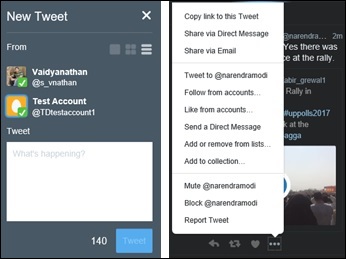
To remove an account from TweetDeck, simply go to Accounts on the left pane, expand the desired account and click on Leave this team to remove the account from TweetDeck.
TweetDeck - Team Access
TweetDecks Teams feature is one of its USPs. The Teams feature allows delegating access to other TweetDeck users without the need for sharing passwords. However, all team members need to use TweetDeck for this purpose. Team members can have one of the following roles −
Owner − Manages passwords and login verification; invites others as admins or contributors and can act on behalf of the team (tweeting, retweeting, direct messaging etc.)
Admin − Invites others as admins or contributors and can act on behalf of the team.
Contributor − Acts on behalf of the team.
To start a Team, go to the Accounts page on the side pane and under the desired profile to be designated as Owner, click on Team @(username). It opens a Manage Team flyout where you can add your team members and authorize them. The authorized team members will receive an email invite which needs to be accepted before they can take on the designated roles. They will then need to login to their TweetDeck app and accept the invite in the Accounts section of their app.
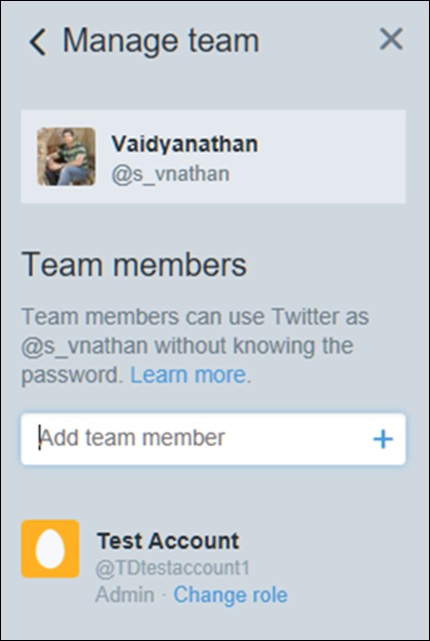
The added team members can be assigned as Admin or Contributor roles by clicking on Change Role for each team member.
While only the Owner gets to manage the password and login settings, both Owners and Admins can manage the team.
Contributors can only post and cannot manage team accounts.
It is also possible to remove a member from the team by clicking on Change Role next to the user and selecting Remove from team.
For the Teams feature to be effectively utilized, the following criteria must be met
All team members must be using TweetDeck and accept the invitation email.
Team members should allow invitations in the Twitter for teams section in the Privacy and Safety settings on twitter.com
Tweet Scheduling
TweetDeck allows scheduling tweets to be sent at a specified date and time. For multiple accounts, tweets can be scheduled for each of them. For scheduling a tweet, click on the New Tweet button on the side pane, type out your tweet and click on Schedule Tweet. This allows the option to select a date and time on the calendar.

Simply select the desired date and time and click on Tweet to send the tweet at the specified time.
Changed your mind about a scheduled tweet? No problem! It is possible to view all your scheduled tweets by adding a Scheduled column to the list of columns. Interestingly, the Scheduled column allows showing the merged schedules from all the accounts added to TweetDeck. Once the tweet is scheduled, you can even exit the app in full confidence that the tweet will be posted as per the schedule.
TweetDeck - Advanced Functions
TweetDeck supports a host of advanced functions. In this chapter, we shall review two of them, which are −
- Collections and
- Lists
Let us begin with Collections and then later we will discuss regarding the Lists function.
Collections
Collections are organized tweets based on topics, interests, conversations, etc. A collection can be added as a column in TweetDeck and the link to the Collection can be shared with other users.
From the Add Column menu described earlier, select Collections. Select the account to which the Collection belongs to (if using multiple accounts) and enter a name for the Collection and an optional description and click on Save.
These can be changed even after the Collection is created.
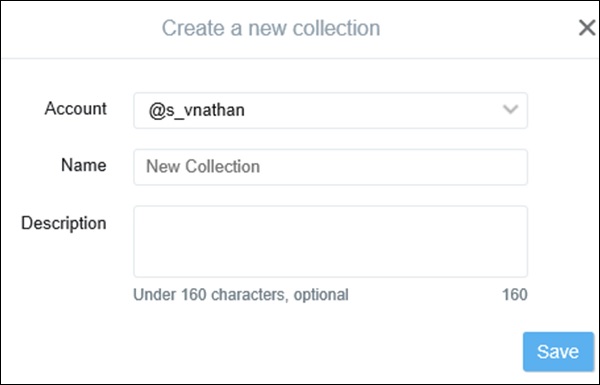
You can drag and drop tweets onto this pane or select Add to Collection from the ellipses under each tweet. A tweet can be added to multiple collections at a time. Each new tweet added is placed first in the Collection, but the order can be customized by dragging each tweet and dropping them in the desired position.
To remove a tweet from a collection, click on the X icon on the tweet within the collection. Collections can be embedded, viewed on twitter.com or tweeted about.
Lists
A list is a group of Twitter accounts. A list allows streaming only the updates from the accounts in that list. To create a list in TweetDeck, click on Add Column on the side pane and then click on Lists. Then click on Create List and select the options as described for Collections. An option here is to make the list either Public or Private.
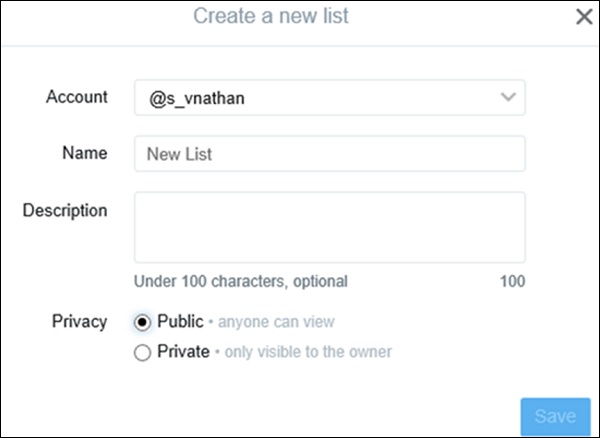
One can subscribe to public lists which can offer valuable information such as the details of upcoming conferences, job lists, news updates, etc. Like Collections, the list can be edited post creation and can also be embedded on the timeline.
TweetDeck - Pro-Tips
We have seen some ways by which TweetDeck can greatly enhance the stock Twitter experience. But there is still more than meets the eye. TweetDeck offers some neat ways to spruce up your daily Twitter work and if you happen to live your second life on Twitter, these tips could surely come in handy.
Search Tools
Twitter is a vast resource. Therefore, effective search tools are needed to get to the people and topics that matter most to you.
TweetDeck builds on the search capabilities of the native Twitter client by giving more options for refining searches. New searches open in a separate pane which allows for further filtering.
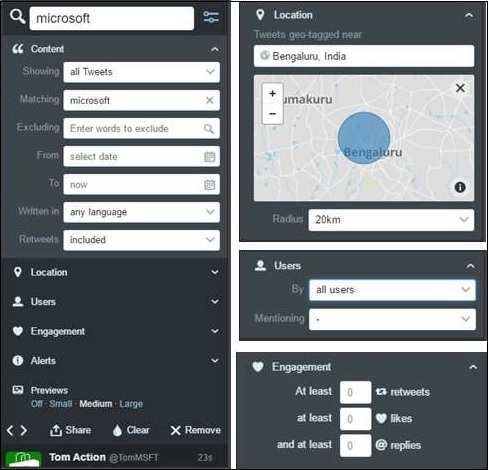
As you can see in the above screenshot, searching for Microsoft has opened a new search pane with many options.
The Content function allows searching based on specific keywords. It allows for exclusion of certain words or phrases and allows searching for tweets in a specified time frame in any or a certain language.
The Location function allows filtering of tweets matching the keyword from a given geolocation. It is useful if you want to follow topics relevant to a specific region. You can filter results up to a radius of 100 Kms from your chosen location.
The Users function allows you to narrow down tweets on the topic from a specific user or as mentioned by a specific user.
The Engagement function allows filtering of results based on the number of retweets, likes or replies. This is useful if you only want to see the tweets that have been popular for this search.
Of course, like other panes, you can also get notifications whenever there is an updated result for this search and embed the search on your website or blog, you can then share the search on your timeline. You can also search for a specific user and display a column for results from that user alone.
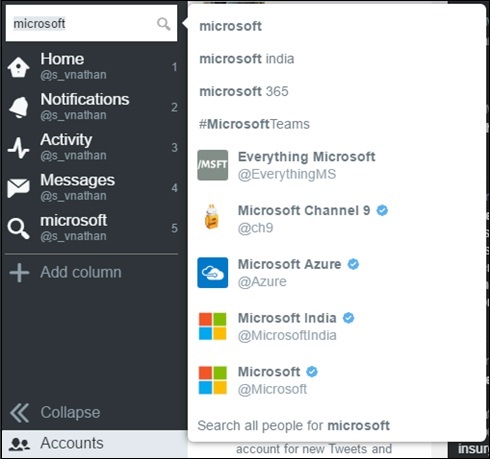
You can even take this up a notch further. As you type the search query in the Search box, TweetDeck runs a real-time search that will auto-suggest some of the matching terms. You can then select from the suggested results directly and open them in a new pane.
Here is the cool part. For example, you want to read a topic with a specific sentiment, just type a happy or sad emoticon followed by the search term. For example, Microsoft :) will show only the positive results for Microsoft.
You can also filter keywords directly from the Search box. For example, #microsoft filter:news will show only the news topics having the hashtag Microsoft. Also, just like the good old command line on your PC, it is possible to add wildcards to searches. Searching for Microsoft is *. will return all sorts of searches containing Microsoft is.
For even more search tips and Boolean operations on searches, go to Settings and click on Search tips.
Embedding Tweets
You may want to embed tweets of interest in your blog or website. TweetDeck makes it easy to do so. Just go the desired tweet, click on the ellipses and select Embed this Tweet from the menu. Doing so opens a dialog box that contains the HTML code for the tweet along with a preview of how it will appear on your website. If the tweet is part of a conversation, you can choose to include the parent tweet as well.
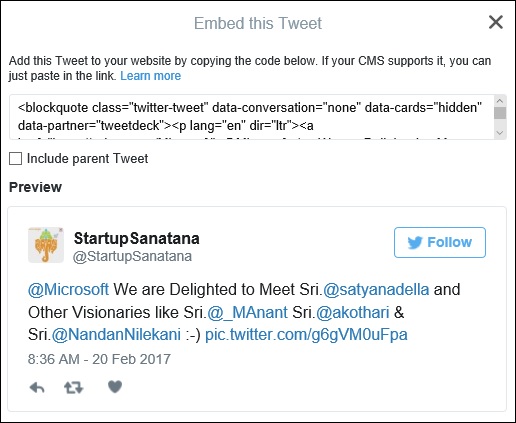
Users who visit your blog or website can directly follow, reply, like or retweet this tweet from this embedded code if they wish to. This works great for news, marketing or for sharing information on just about anything.
Keyboard Shortcuts
Ask any power-user worth their salt and the first thing they would prefer learning about any software program are keyboard shortcuts. Keyboard shortcuts increase productivity manifold and are especially helpful when you are living and breathing Twitter.
The following keyboard shortcuts are available for TweetDeck users
From Anywhere Within TweetDeck
| Key | Function |
|---|---|
| A | Add a Column |
| S | Search |
| N | New Tweet |
| CTRL/CMD+return | Send new tweet |
| ESC | Close pop-up/cancel search |
| ? | Show full keyboard shortcut list |
Tweet Navigation
| Key | Function |
|---|---|
| 1-9 | Navigate through columns 1 through 9 |
| 0 | Jump to last column on the right |
| Left arrow | Move selection left |
| Right arrow | Move selection right |
| Up arrow | Move selection up |
| Down arrow | Move selection down |
Tweet Actions
| Key | Function |
|---|---|
| Return/Enter | Opens selected tweet |
| Backspace/Delete | Takes you back to the main column |
| R | Directly reply to a tweet from a column |
| T | Directly retweet a tweet from a column |
| F | Like the tweet |
| D | Direct Message the author |
| P | Show user profile of the tweet author |
TweetDeck - Common Troubleshooting
With any software, there will be instances where you run into issues, it is the same while using TweetDeck too. This troubleshooting guide can help point out some of the common issues that you are likely to encounter.
Most of these issues can be fixed by simply logging out, clearing the browser cache and logging back in again if you are accessing via a browser or simply by restarting or updating the TweetDeck client, if using an app.
Trouble Logging in
If you have trouble logging in to TweetDeck, try logging into the Twitter web client first to ensure that the account is active and the login credentials are correct.
If you have forgotten the password or you think your account could have been compromised, you can reset the password from Twitter by following the instructions available on the following link https://help.x.com/en/managing-your-account/forgotten-or-lost-password-reset
Columns and Accounts Disappeared
Check that you are logged into the correct account by clicking on the Settings icon on the side pane. Ensure that your account is not compromised by resetting your password as described above. Try refreshing the page and login again.
Providing Feedback
If all else fails and you are still not able to login to TweetDeck, you can try contacting Twitter Support. Twitter Support might request additional data from you, so it helps to keep the following information handy
For the App Version - Can be known by going to Settings and clicking on General.
Information from the Javascript console of your browser − Twitter recommends Chrome (PC) or Safari (Mac) for this. Open TweetDeck in Chrome and go to the More Tools menu in Chrome and select Developer Tools or simply press CTRL+Shift+I. Select the Console tab and at the bottom of the page, near the cursor, paste the following line there -copy(JSON.stringify(TD.storage.store.jsonDump())) and press Enter.
A new window will open which will bring up some information logs which Twitter Support might request for when troubleshooting a problem. Safari users can bring up the Web Inspector and enable debugging on the Scripts tab before pasting the above line in the cursor. Other browsers may or may not provide relevant information in their Developer modes, so be sure to use Chrome or Safari for maximum compatibility.
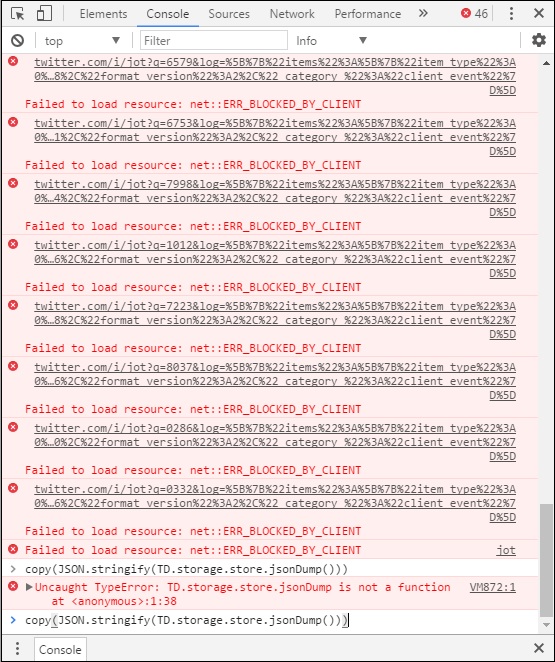
TweetDeck - Development Status
TweetDeck has undergone a lot of front-end and back-end changes since its inception in year 2008. The earlier versions of TweetDeck had native apps for almost all platforms including −
- Windows
- MacOS
- Android
- iOS
- Chrome and
- Web
However, with the aim of streamlining development and to provide a great user experience, Twitter has decided to suspend development of TweetDeck on all platforms except for Chrome, MacOS and the Web. The Windows AIR client was suspended in April, 2016.
The Web and Chrome apps are where the maximum focus is on to bring updates and enhancements. The other apps relied on v1.0 of the Twitter API which was eventually retired, rendering the apps useless. It is to be noted that the performance of TweetDeck is best when used via any WebKit Enabled Browser such as Chrome or Safari. The Web app gets the maximum updates by way of weekly releases.
TweetDeck Alternatives
Although Twitter has suspended development of TweetDeck on many platforms, it is still available on Chrome and the Web. But many users who are on Windows or iOS would prefer native apps for their platform to take advantage of platform specific APIs such as Cortana, Pen and Ink on Windows 10, for example.
Third-party native apps have great functionality and developer support and can be worthwhile Twitter Clients even if they are a little expensive.
Tweeten App
On Windows platform, there is an app called Tweeten which aims to provide a modern TweetDeck experience to users. The best part about Tweeten is its wide availability. It is available as a modern UWA app, as a traditional Win32 app (x86 and x64), as an extension for Edge and Chrome and as a MacOS app.
On each platform, the app leverages the native functionality of the OS and provides a modern, seamless interface. Tweeten has the look and feel of TweetDeck with some niceties built in. For example, you can adjust the column width as per your liking instead of having to rely on fixed width sizes.
The app is still in beta and is being actively developed. You can download the app for your platform of choice from https://tweetenapp.com/
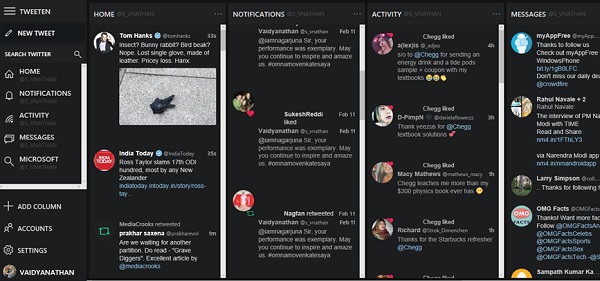
Other alternatives like Hootsuite and Aries for Twitter (Windows Phone) and Plume are equally good options you may want to consider if you are looking for a native Twitter client that ties into platform specific features.